Analysis of Visitor Satisfaction and Attractions
VerifiedAdded on 2020/07/23
|16
|5532
|438
AI Summary
This assignment provides a comprehensive analysis of visitor satisfaction and attractions in the context of tourism studies. It includes various research articles and studies that explore different aspects of tourist attractions, such as destination image, visitor behavior, and event management. The assignment also touches on sustainability assessments and management processes. It is suitable for students studying tourism, hospitality, or related fields.
Contribute Materials
Your contribution can guide someone’s learning journey. Share your
documents today.
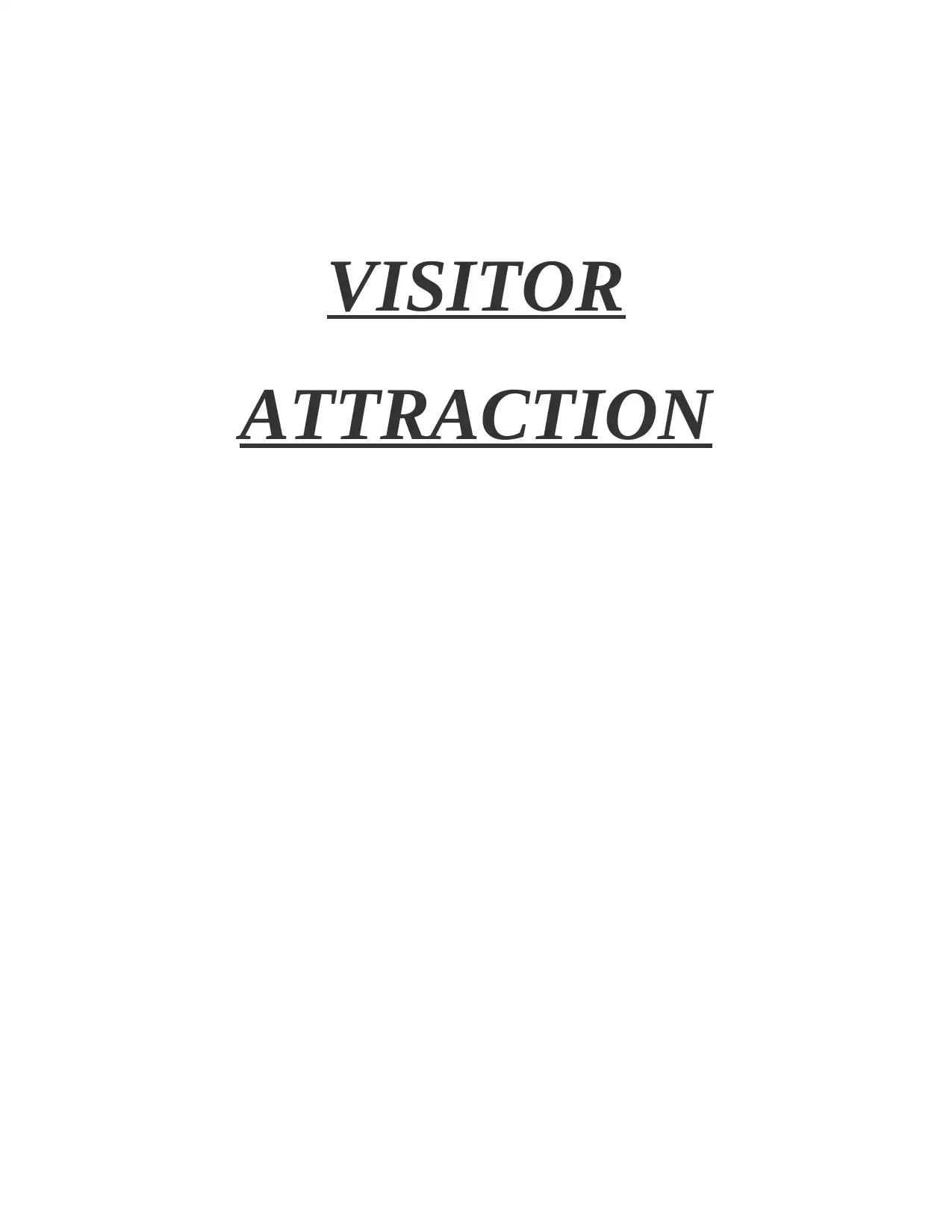
VISITOR
ATTRACTION
ATTRACTION
Secure Best Marks with AI Grader
Need help grading? Try our AI Grader for instant feedback on your assignments.
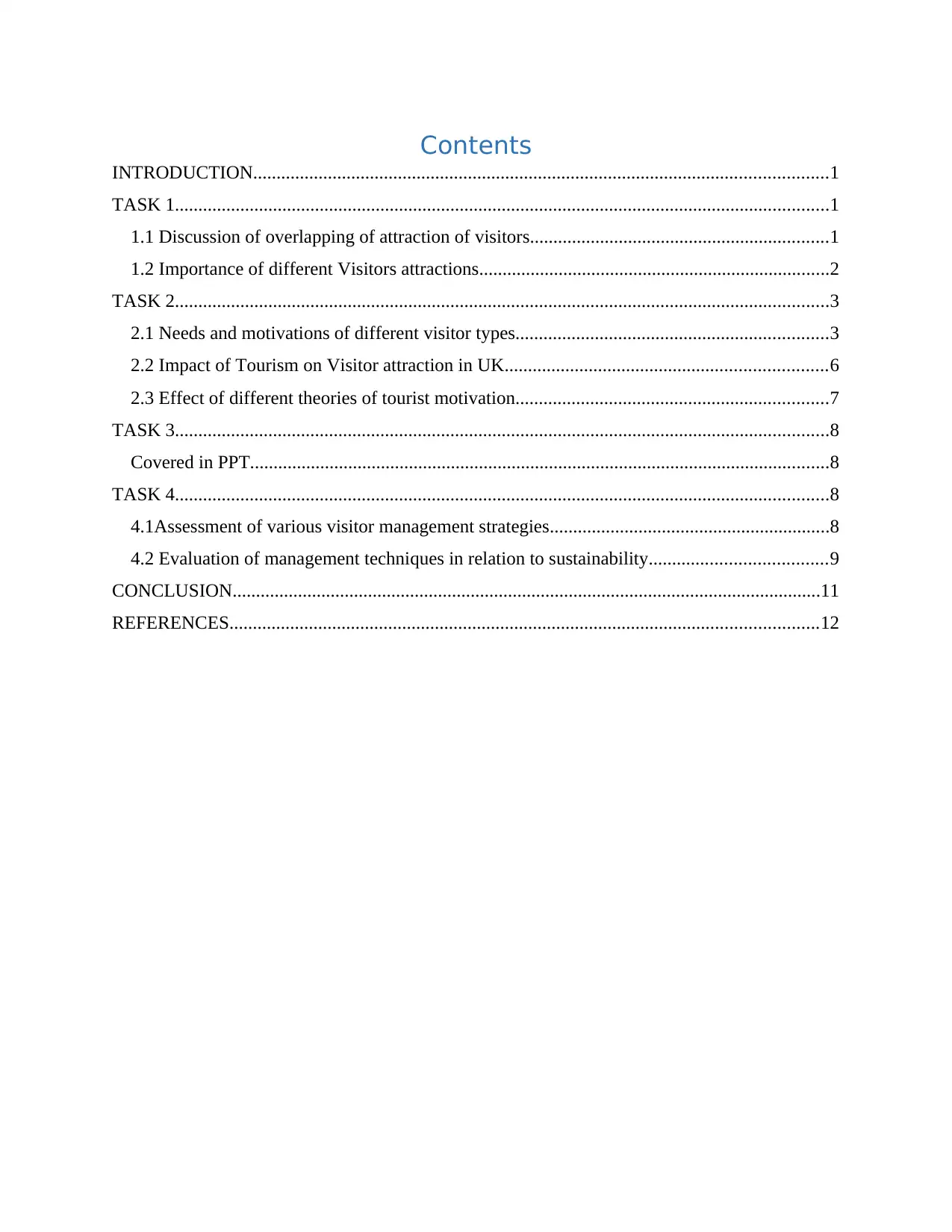
Contents
INTRODUCTION...........................................................................................................................1
TASK 1............................................................................................................................................1
1.1 Discussion of overlapping of attraction of visitors................................................................1
1.2 Importance of different Visitors attractions...........................................................................2
TASK 2............................................................................................................................................3
2.1 Needs and motivations of different visitor types...................................................................3
2.2 Impact of Tourism on Visitor attraction in UK.....................................................................6
2.3 Effect of different theories of tourist motivation...................................................................7
TASK 3............................................................................................................................................8
Covered in PPT............................................................................................................................8
TASK 4............................................................................................................................................8
4.1Assessment of various visitor management strategies............................................................8
4.2 Evaluation of management techniques in relation to sustainability......................................9
CONCLUSION..............................................................................................................................11
REFERENCES..............................................................................................................................12
INTRODUCTION...........................................................................................................................1
TASK 1............................................................................................................................................1
1.1 Discussion of overlapping of attraction of visitors................................................................1
1.2 Importance of different Visitors attractions...........................................................................2
TASK 2............................................................................................................................................3
2.1 Needs and motivations of different visitor types...................................................................3
2.2 Impact of Tourism on Visitor attraction in UK.....................................................................6
2.3 Effect of different theories of tourist motivation...................................................................7
TASK 3............................................................................................................................................8
Covered in PPT............................................................................................................................8
TASK 4............................................................................................................................................8
4.1Assessment of various visitor management strategies............................................................8
4.2 Evaluation of management techniques in relation to sustainability......................................9
CONCLUSION..............................................................................................................................11
REFERENCES..............................................................................................................................12
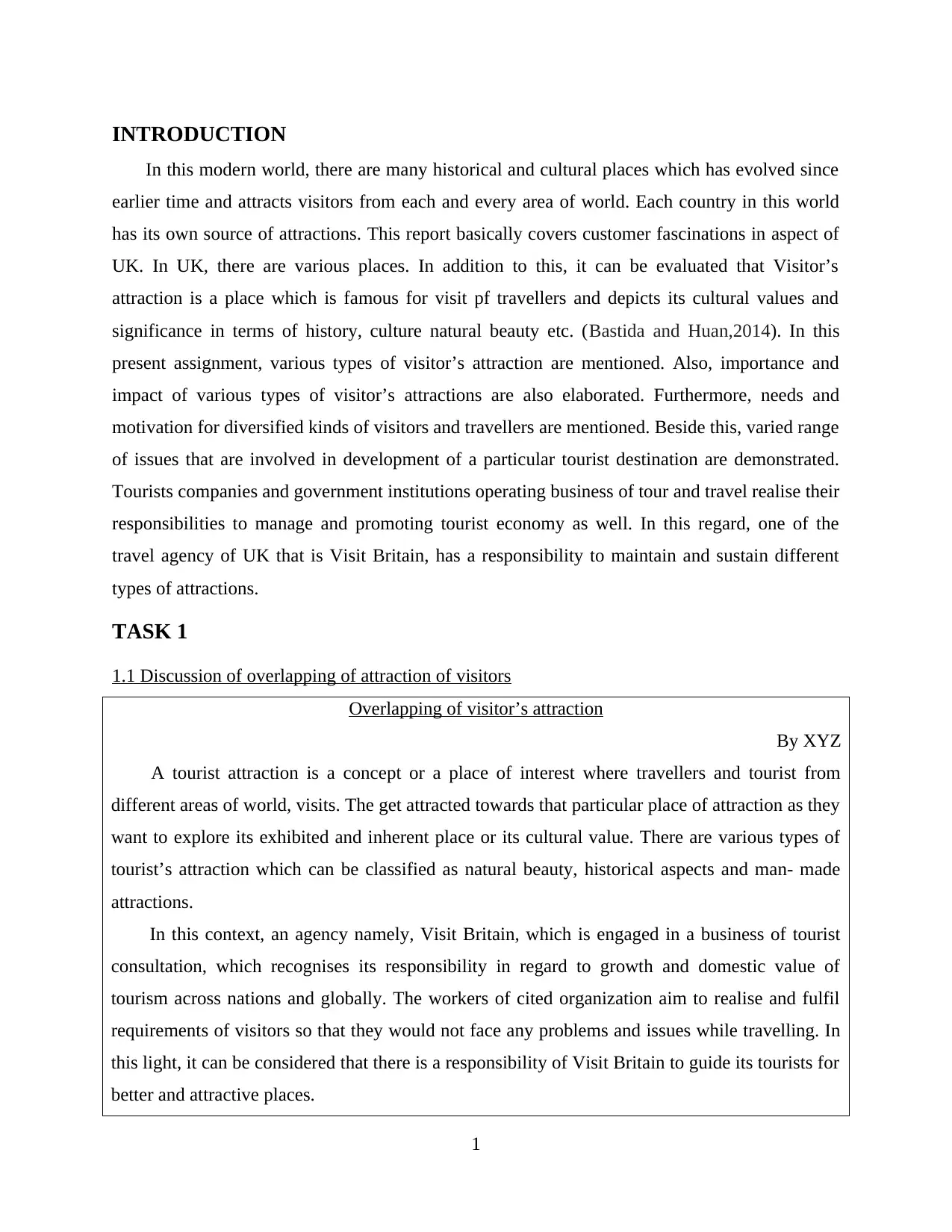
INTRODUCTION
In this modern world, there are many historical and cultural places which has evolved since
earlier time and attracts visitors from each and every area of world. Each country in this world
has its own source of attractions. This report basically covers customer fascinations in aspect of
UK. In UK, there are various places. In addition to this, it can be evaluated that Visitor’s
attraction is a place which is famous for visit pf travellers and depicts its cultural values and
significance in terms of history, culture natural beauty etc. (Bastida and Huan,2014). In this
present assignment, various types of visitor’s attraction are mentioned. Also, importance and
impact of various types of visitor’s attractions are also elaborated. Furthermore, needs and
motivation for diversified kinds of visitors and travellers are mentioned. Beside this, varied range
of issues that are involved in development of a particular tourist destination are demonstrated.
Tourists companies and government institutions operating business of tour and travel realise their
responsibilities to manage and promoting tourist economy as well. In this regard, one of the
travel agency of UK that is Visit Britain, has a responsibility to maintain and sustain different
types of attractions.
TASK 1
1.1 Discussion of overlapping of attraction of visitors
Overlapping of visitor’s attraction
By XYZ
A tourist attraction is a concept or a place of interest where travellers and tourist from
different areas of world, visits. The get attracted towards that particular place of attraction as they
want to explore its exhibited and inherent place or its cultural value. There are various types of
tourist’s attraction which can be classified as natural beauty, historical aspects and man- made
attractions.
In this context, an agency namely, Visit Britain, which is engaged in a business of tourist
consultation, which recognises its responsibility in regard to growth and domestic value of
tourism across nations and globally. The workers of cited organization aim to realise and fulfil
requirements of visitors so that they would not face any problems and issues while travelling. In
this light, it can be considered that there is a responsibility of Visit Britain to guide its tourists for
better and attractive places.
1
In this modern world, there are many historical and cultural places which has evolved since
earlier time and attracts visitors from each and every area of world. Each country in this world
has its own source of attractions. This report basically covers customer fascinations in aspect of
UK. In UK, there are various places. In addition to this, it can be evaluated that Visitor’s
attraction is a place which is famous for visit pf travellers and depicts its cultural values and
significance in terms of history, culture natural beauty etc. (Bastida and Huan,2014). In this
present assignment, various types of visitor’s attraction are mentioned. Also, importance and
impact of various types of visitor’s attractions are also elaborated. Furthermore, needs and
motivation for diversified kinds of visitors and travellers are mentioned. Beside this, varied range
of issues that are involved in development of a particular tourist destination are demonstrated.
Tourists companies and government institutions operating business of tour and travel realise their
responsibilities to manage and promoting tourist economy as well. In this regard, one of the
travel agency of UK that is Visit Britain, has a responsibility to maintain and sustain different
types of attractions.
TASK 1
1.1 Discussion of overlapping of attraction of visitors
Overlapping of visitor’s attraction
By XYZ
A tourist attraction is a concept or a place of interest where travellers and tourist from
different areas of world, visits. The get attracted towards that particular place of attraction as they
want to explore its exhibited and inherent place or its cultural value. There are various types of
tourist’s attraction which can be classified as natural beauty, historical aspects and man- made
attractions.
In this context, an agency namely, Visit Britain, which is engaged in a business of tourist
consultation, which recognises its responsibility in regard to growth and domestic value of
tourism across nations and globally. The workers of cited organization aim to realise and fulfil
requirements of visitors so that they would not face any problems and issues while travelling. In
this light, it can be considered that there is a responsibility of Visit Britain to guide its tourists for
better and attractive places.
1
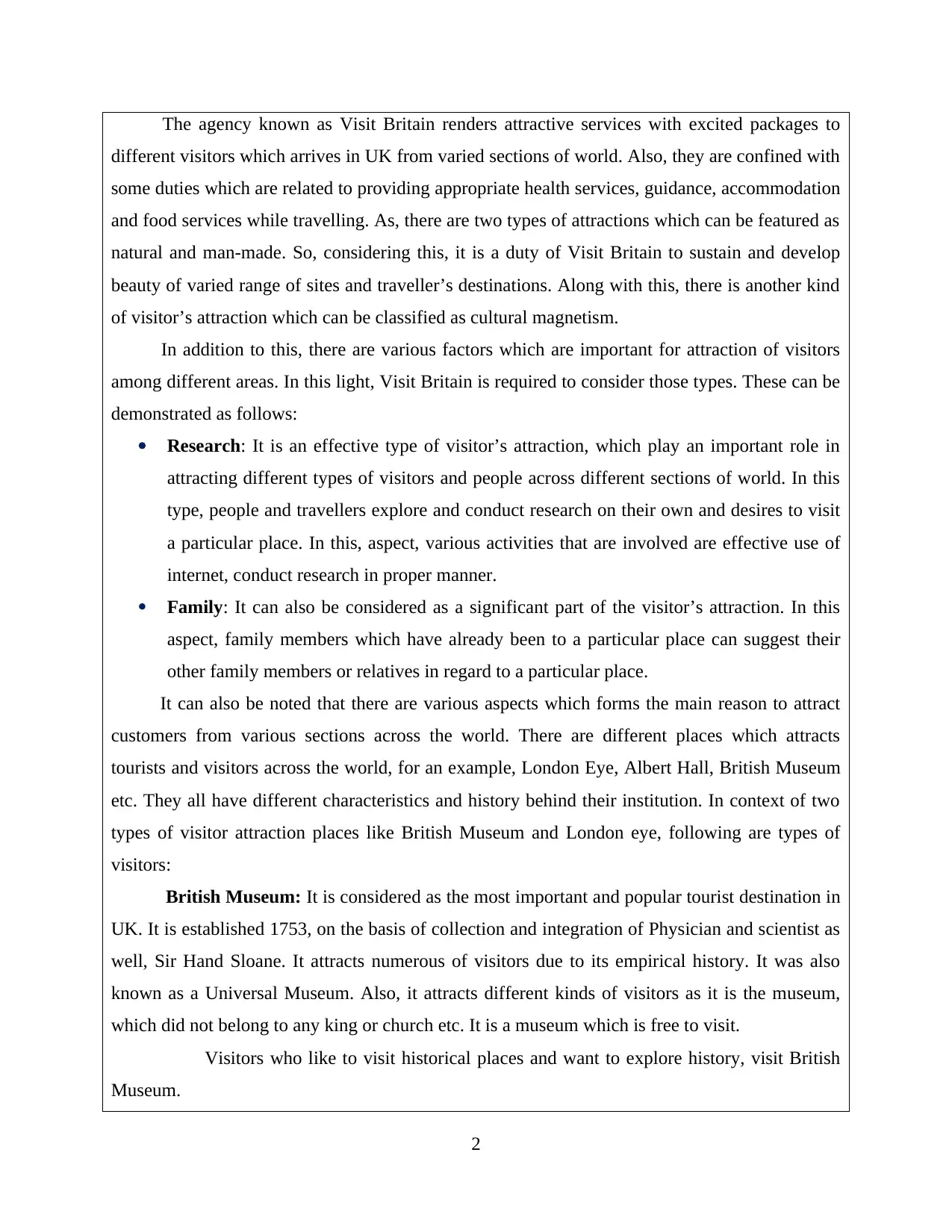
The agency known as Visit Britain renders attractive services with excited packages to
different visitors which arrives in UK from varied sections of world. Also, they are confined with
some duties which are related to providing appropriate health services, guidance, accommodation
and food services while travelling. As, there are two types of attractions which can be featured as
natural and man-made. So, considering this, it is a duty of Visit Britain to sustain and develop
beauty of varied range of sites and traveller’s destinations. Along with this, there is another kind
of visitor’s attraction which can be classified as cultural magnetism.
In addition to this, there are various factors which are important for attraction of visitors
among different areas. In this light, Visit Britain is required to consider those types. These can be
demonstrated as follows:
Research: It is an effective type of visitor’s attraction, which play an important role in
attracting different types of visitors and people across different sections of world. In this
type, people and travellers explore and conduct research on their own and desires to visit
a particular place. In this, aspect, various activities that are involved are effective use of
internet, conduct research in proper manner.
Family: It can also be considered as a significant part of the visitor’s attraction. In this
aspect, family members which have already been to a particular place can suggest their
other family members or relatives in regard to a particular place.
It can also be noted that there are various aspects which forms the main reason to attract
customers from various sections across the world. There are different places which attracts
tourists and visitors across the world, for an example, London Eye, Albert Hall, British Museum
etc. They all have different characteristics and history behind their institution. In context of two
types of visitor attraction places like British Museum and London eye, following are types of
visitors:
British Museum: It is considered as the most important and popular tourist destination in
UK. It is established 1753, on the basis of collection and integration of Physician and scientist as
well, Sir Hand Sloane. It attracts numerous of visitors due to its empirical history. It was also
known as a Universal Museum. Also, it attracts different kinds of visitors as it is the museum,
which did not belong to any king or church etc. It is a museum which is free to visit.
Visitors who like to visit historical places and want to explore history, visit British
Museum.
2
different visitors which arrives in UK from varied sections of world. Also, they are confined with
some duties which are related to providing appropriate health services, guidance, accommodation
and food services while travelling. As, there are two types of attractions which can be featured as
natural and man-made. So, considering this, it is a duty of Visit Britain to sustain and develop
beauty of varied range of sites and traveller’s destinations. Along with this, there is another kind
of visitor’s attraction which can be classified as cultural magnetism.
In addition to this, there are various factors which are important for attraction of visitors
among different areas. In this light, Visit Britain is required to consider those types. These can be
demonstrated as follows:
Research: It is an effective type of visitor’s attraction, which play an important role in
attracting different types of visitors and people across different sections of world. In this
type, people and travellers explore and conduct research on their own and desires to visit
a particular place. In this, aspect, various activities that are involved are effective use of
internet, conduct research in proper manner.
Family: It can also be considered as a significant part of the visitor’s attraction. In this
aspect, family members which have already been to a particular place can suggest their
other family members or relatives in regard to a particular place.
It can also be noted that there are various aspects which forms the main reason to attract
customers from various sections across the world. There are different places which attracts
tourists and visitors across the world, for an example, London Eye, Albert Hall, British Museum
etc. They all have different characteristics and history behind their institution. In context of two
types of visitor attraction places like British Museum and London eye, following are types of
visitors:
British Museum: It is considered as the most important and popular tourist destination in
UK. It is established 1753, on the basis of collection and integration of Physician and scientist as
well, Sir Hand Sloane. It attracts numerous of visitors due to its empirical history. It was also
known as a Universal Museum. Also, it attracts different kinds of visitors as it is the museum,
which did not belong to any king or church etc. It is a museum which is free to visit.
Visitors who like to visit historical places and want to explore history, visit British
Museum.
2
Secure Best Marks with AI Grader
Need help grading? Try our AI Grader for instant feedback on your assignments.
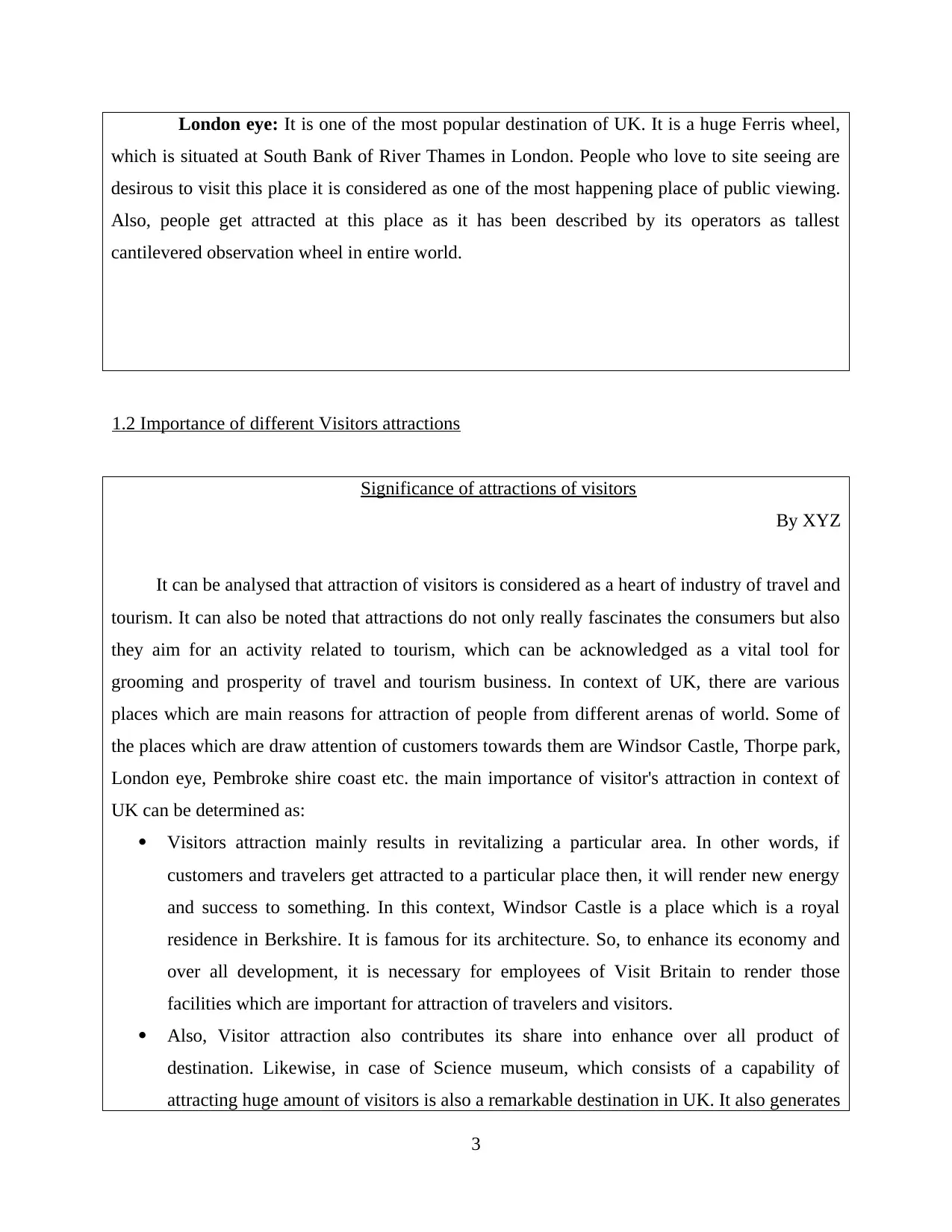
London eye: It is one of the most popular destination of UK. It is a huge Ferris wheel,
which is situated at South Bank of River Thames in London. People who love to site seeing are
desirous to visit this place it is considered as one of the most happening place of public viewing.
Also, people get attracted at this place as it has been described by its operators as tallest
cantilevered observation wheel in entire world.
1.2 Importance of different Visitors attractions
Significance of attractions of visitors
By XYZ
It can be analysed that attraction of visitors is considered as a heart of industry of travel and
tourism. It can also be noted that attractions do not only really fascinates the consumers but also
they aim for an activity related to tourism, which can be acknowledged as a vital tool for
grooming and prosperity of travel and tourism business. In context of UK, there are various
places which are main reasons for attraction of people from different arenas of world. Some of
the places which are draw attention of customers towards them are Windsor Castle, Thorpe park,
London eye, Pembroke shire coast etc. the main importance of visitor's attraction in context of
UK can be determined as:
Visitors attraction mainly results in revitalizing a particular area. In other words, if
customers and travelers get attracted to a particular place then, it will render new energy
and success to something. In this context, Windsor Castle is a place which is a royal
residence in Berkshire. It is famous for its architecture. So, to enhance its economy and
over all development, it is necessary for employees of Visit Britain to render those
facilities which are important for attraction of travelers and visitors.
Also, Visitor attraction also contributes its share into enhance over all product of
destination. Likewise, in case of Science museum, which consists of a capability of
attracting huge amount of visitors is also a remarkable destination in UK. It also generates
3
which is situated at South Bank of River Thames in London. People who love to site seeing are
desirous to visit this place it is considered as one of the most happening place of public viewing.
Also, people get attracted at this place as it has been described by its operators as tallest
cantilevered observation wheel in entire world.
1.2 Importance of different Visitors attractions
Significance of attractions of visitors
By XYZ
It can be analysed that attraction of visitors is considered as a heart of industry of travel and
tourism. It can also be noted that attractions do not only really fascinates the consumers but also
they aim for an activity related to tourism, which can be acknowledged as a vital tool for
grooming and prosperity of travel and tourism business. In context of UK, there are various
places which are main reasons for attraction of people from different arenas of world. Some of
the places which are draw attention of customers towards them are Windsor Castle, Thorpe park,
London eye, Pembroke shire coast etc. the main importance of visitor's attraction in context of
UK can be determined as:
Visitors attraction mainly results in revitalizing a particular area. In other words, if
customers and travelers get attracted to a particular place then, it will render new energy
and success to something. In this context, Windsor Castle is a place which is a royal
residence in Berkshire. It is famous for its architecture. So, to enhance its economy and
over all development, it is necessary for employees of Visit Britain to render those
facilities which are important for attraction of travelers and visitors.
Also, Visitor attraction also contributes its share into enhance over all product of
destination. Likewise, in case of Science museum, which consists of a capability of
attracting huge amount of visitors is also a remarkable destination in UK. It also generates
3
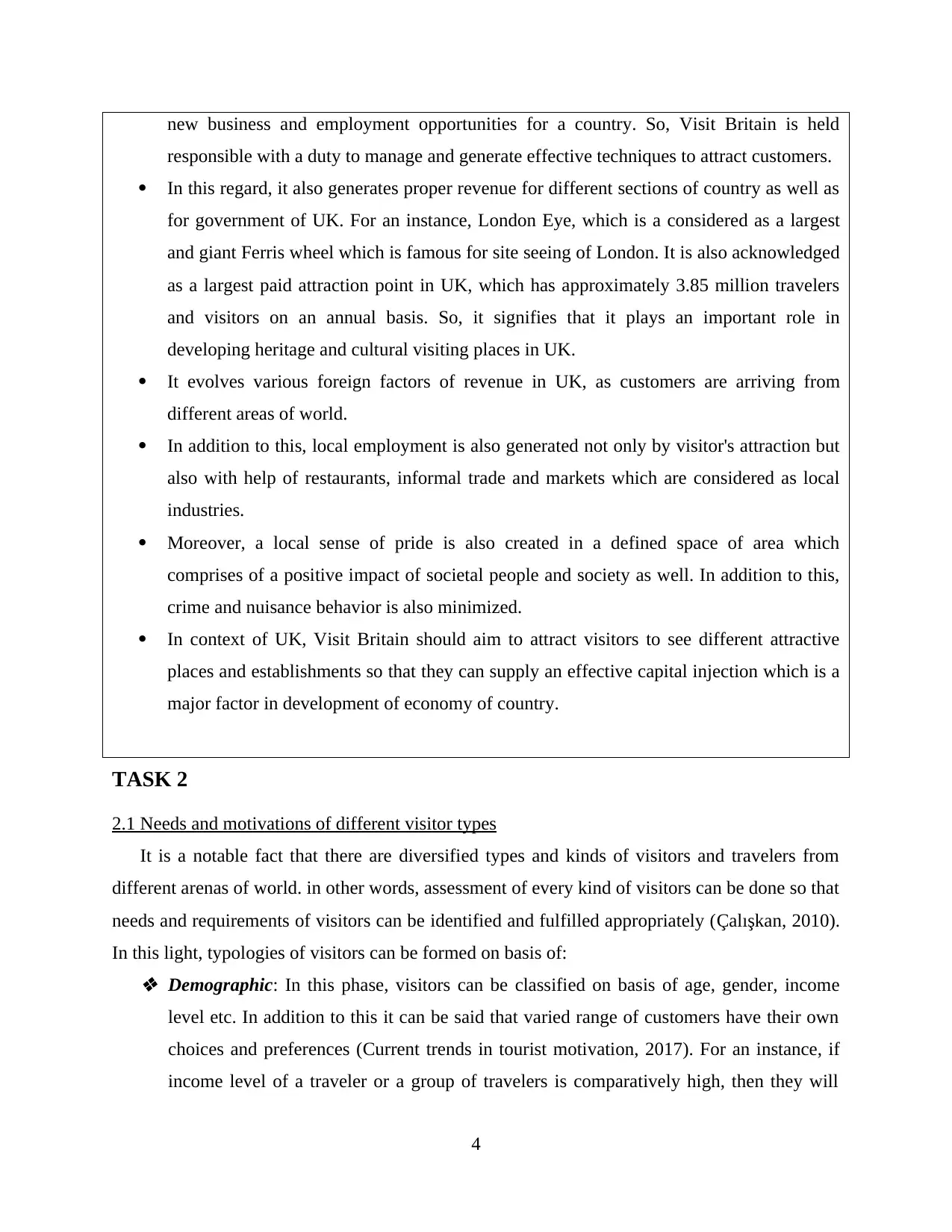
new business and employment opportunities for a country. So, Visit Britain is held
responsible with a duty to manage and generate effective techniques to attract customers.
In this regard, it also generates proper revenue for different sections of country as well as
for government of UK. For an instance, London Eye, which is a considered as a largest
and giant Ferris wheel which is famous for site seeing of London. It is also acknowledged
as a largest paid attraction point in UK, which has approximately 3.85 million travelers
and visitors on an annual basis. So, it signifies that it plays an important role in
developing heritage and cultural visiting places in UK.
It evolves various foreign factors of revenue in UK, as customers are arriving from
different areas of world.
In addition to this, local employment is also generated not only by visitor's attraction but
also with help of restaurants, informal trade and markets which are considered as local
industries.
Moreover, a local sense of pride is also created in a defined space of area which
comprises of a positive impact of societal people and society as well. In addition to this,
crime and nuisance behavior is also minimized.
In context of UK, Visit Britain should aim to attract visitors to see different attractive
places and establishments so that they can supply an effective capital injection which is a
major factor in development of economy of country.
TASK 2
2.1 Needs and motivations of different visitor types
It is a notable fact that there are diversified types and kinds of visitors and travelers from
different arenas of world. in other words, assessment of every kind of visitors can be done so that
needs and requirements of visitors can be identified and fulfilled appropriately (Çalışkan, 2010).
In this light, typologies of visitors can be formed on basis of: Demographic: In this phase, visitors can be classified on basis of age, gender, income
level etc. In addition to this it can be said that varied range of customers have their own
choices and preferences (Current trends in tourist motivation, 2017). For an instance, if
income level of a traveler or a group of travelers is comparatively high, then they will
4
responsible with a duty to manage and generate effective techniques to attract customers.
In this regard, it also generates proper revenue for different sections of country as well as
for government of UK. For an instance, London Eye, which is a considered as a largest
and giant Ferris wheel which is famous for site seeing of London. It is also acknowledged
as a largest paid attraction point in UK, which has approximately 3.85 million travelers
and visitors on an annual basis. So, it signifies that it plays an important role in
developing heritage and cultural visiting places in UK.
It evolves various foreign factors of revenue in UK, as customers are arriving from
different areas of world.
In addition to this, local employment is also generated not only by visitor's attraction but
also with help of restaurants, informal trade and markets which are considered as local
industries.
Moreover, a local sense of pride is also created in a defined space of area which
comprises of a positive impact of societal people and society as well. In addition to this,
crime and nuisance behavior is also minimized.
In context of UK, Visit Britain should aim to attract visitors to see different attractive
places and establishments so that they can supply an effective capital injection which is a
major factor in development of economy of country.
TASK 2
2.1 Needs and motivations of different visitor types
It is a notable fact that there are diversified types and kinds of visitors and travelers from
different arenas of world. in other words, assessment of every kind of visitors can be done so that
needs and requirements of visitors can be identified and fulfilled appropriately (Çalışkan, 2010).
In this light, typologies of visitors can be formed on basis of: Demographic: In this phase, visitors can be classified on basis of age, gender, income
level etc. In addition to this it can be said that varied range of customers have their own
choices and preferences (Current trends in tourist motivation, 2017). For an instance, if
income level of a traveler or a group of travelers is comparatively high, then they will
4
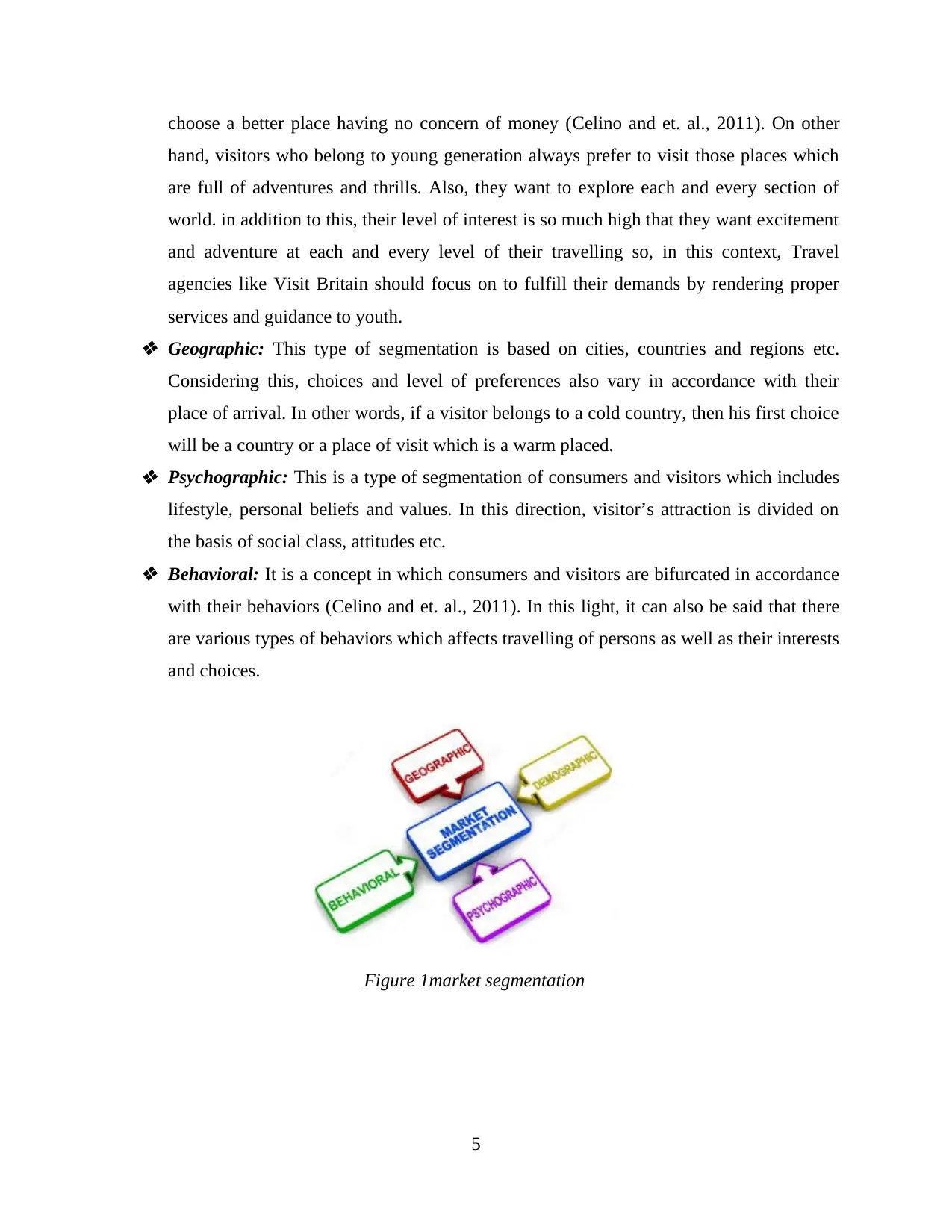
choose a better place having no concern of money (Celino and et. al., 2011). On other
hand, visitors who belong to young generation always prefer to visit those places which
are full of adventures and thrills. Also, they want to explore each and every section of
world. in addition to this, their level of interest is so much high that they want excitement
and adventure at each and every level of their travelling so, in this context, Travel
agencies like Visit Britain should focus on to fulfill their demands by rendering proper
services and guidance to youth. Geographic: This type of segmentation is based on cities, countries and regions etc.
Considering this, choices and level of preferences also vary in accordance with their
place of arrival. In other words, if a visitor belongs to a cold country, then his first choice
will be a country or a place of visit which is a warm placed. Psychographic: This is a type of segmentation of consumers and visitors which includes
lifestyle, personal beliefs and values. In this direction, visitor’s attraction is divided on
the basis of social class, attitudes etc. Behavioral: It is a concept in which consumers and visitors are bifurcated in accordance
with their behaviors (Celino and et. al., 2011). In this light, it can also be said that there
are various types of behaviors which affects travelling of persons as well as their interests
and choices.
Figure 1market segmentation
5
hand, visitors who belong to young generation always prefer to visit those places which
are full of adventures and thrills. Also, they want to explore each and every section of
world. in addition to this, their level of interest is so much high that they want excitement
and adventure at each and every level of their travelling so, in this context, Travel
agencies like Visit Britain should focus on to fulfill their demands by rendering proper
services and guidance to youth. Geographic: This type of segmentation is based on cities, countries and regions etc.
Considering this, choices and level of preferences also vary in accordance with their
place of arrival. In other words, if a visitor belongs to a cold country, then his first choice
will be a country or a place of visit which is a warm placed. Psychographic: This is a type of segmentation of consumers and visitors which includes
lifestyle, personal beliefs and values. In this direction, visitor’s attraction is divided on
the basis of social class, attitudes etc. Behavioral: It is a concept in which consumers and visitors are bifurcated in accordance
with their behaviors (Celino and et. al., 2011). In this light, it can also be said that there
are various types of behaviors which affects travelling of persons as well as their interests
and choices.
Figure 1market segmentation
5
Paraphrase This Document
Need a fresh take? Get an instant paraphrase of this document with our AI Paraphraser
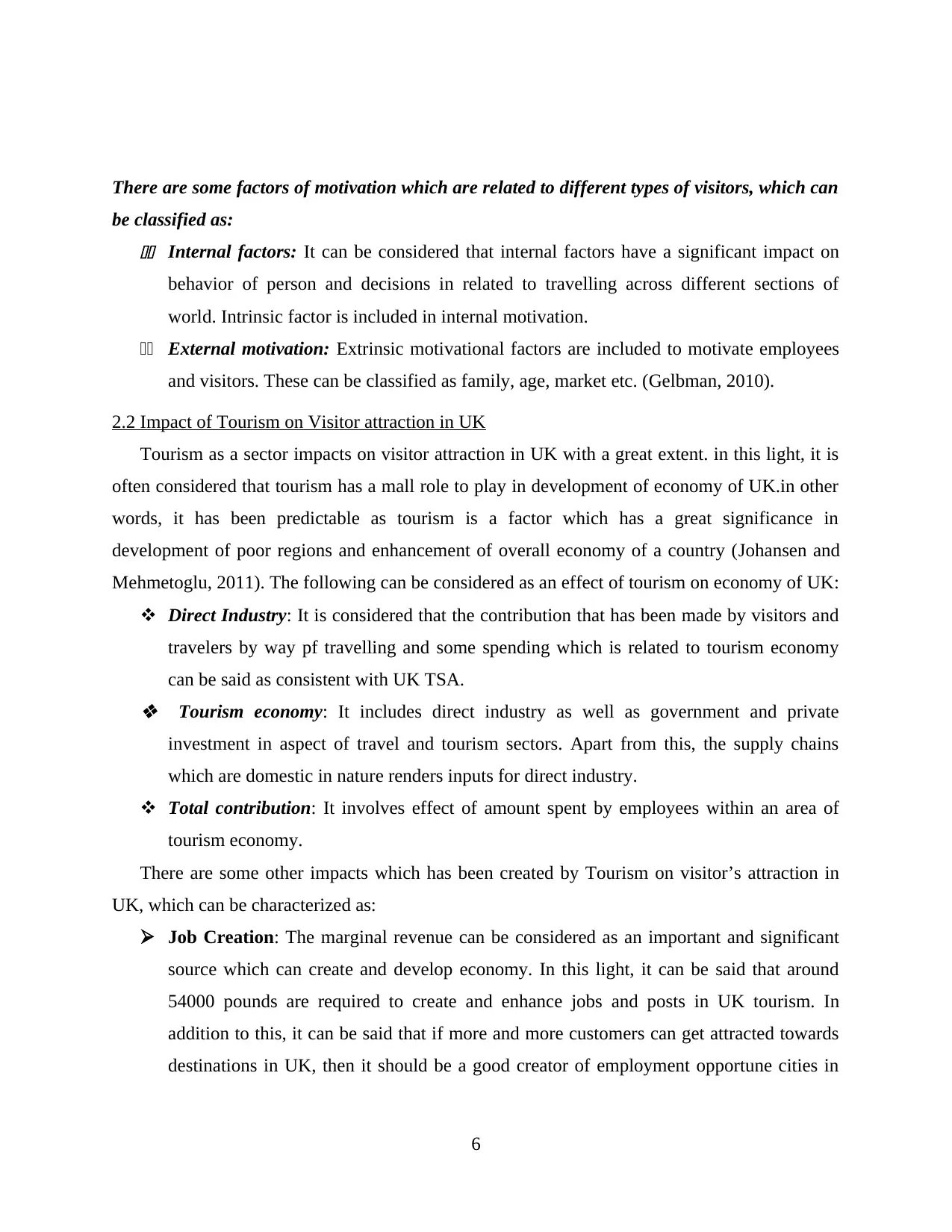
There are some factors of motivation which are related to different types of visitors, which can
be classified as:11 Internal factors: It can be considered that internal factors have a significant impact on
behavior of person and decisions in related to travelling across different sections of
world. Intrinsic factor is included in internal motivation.
11 External motivation: Extrinsic motivational factors are included to motivate employees
and visitors. These can be classified as family, age, market etc. (Gelbman, 2010).
2.2 Impact of Tourism on Visitor attraction in UK
Tourism as a sector impacts on visitor attraction in UK with a great extent. in this light, it is
often considered that tourism has a mall role to play in development of economy of UK.in other
words, it has been predictable as tourism is a factor which has a great significance in
development of poor regions and enhancement of overall economy of a country (Johansen and
Mehmetoglu, 2011). The following can be considered as an effect of tourism on economy of UK:
Direct Industry: It is considered that the contribution that has been made by visitors and
travelers by way pf travelling and some spending which is related to tourism economy
can be said as consistent with UK TSA. Tourism economy: It includes direct industry as well as government and private
investment in aspect of travel and tourism sectors. Apart from this, the supply chains
which are domestic in nature renders inputs for direct industry.
Total contribution: It involves effect of amount spent by employees within an area of
tourism economy.
There are some other impacts which has been created by Tourism on visitor’s attraction in
UK, which can be characterized as:
Job Creation: The marginal revenue can be considered as an important and significant
source which can create and develop economy. In this light, it can be said that around
54000 pounds are required to create and enhance jobs and posts in UK tourism. In
addition to this, it can be said that if more and more customers can get attracted towards
destinations in UK, then it should be a good creator of employment opportune cities in
6
be classified as:11 Internal factors: It can be considered that internal factors have a significant impact on
behavior of person and decisions in related to travelling across different sections of
world. Intrinsic factor is included in internal motivation.
11 External motivation: Extrinsic motivational factors are included to motivate employees
and visitors. These can be classified as family, age, market etc. (Gelbman, 2010).
2.2 Impact of Tourism on Visitor attraction in UK
Tourism as a sector impacts on visitor attraction in UK with a great extent. in this light, it is
often considered that tourism has a mall role to play in development of economy of UK.in other
words, it has been predictable as tourism is a factor which has a great significance in
development of poor regions and enhancement of overall economy of a country (Johansen and
Mehmetoglu, 2011). The following can be considered as an effect of tourism on economy of UK:
Direct Industry: It is considered that the contribution that has been made by visitors and
travelers by way pf travelling and some spending which is related to tourism economy
can be said as consistent with UK TSA. Tourism economy: It includes direct industry as well as government and private
investment in aspect of travel and tourism sectors. Apart from this, the supply chains
which are domestic in nature renders inputs for direct industry.
Total contribution: It involves effect of amount spent by employees within an area of
tourism economy.
There are some other impacts which has been created by Tourism on visitor’s attraction in
UK, which can be characterized as:
Job Creation: The marginal revenue can be considered as an important and significant
source which can create and develop economy. In this light, it can be said that around
54000 pounds are required to create and enhance jobs and posts in UK tourism. In
addition to this, it can be said that if more and more customers can get attracted towards
destinations in UK, then it should be a good creator of employment opportune cities in
6
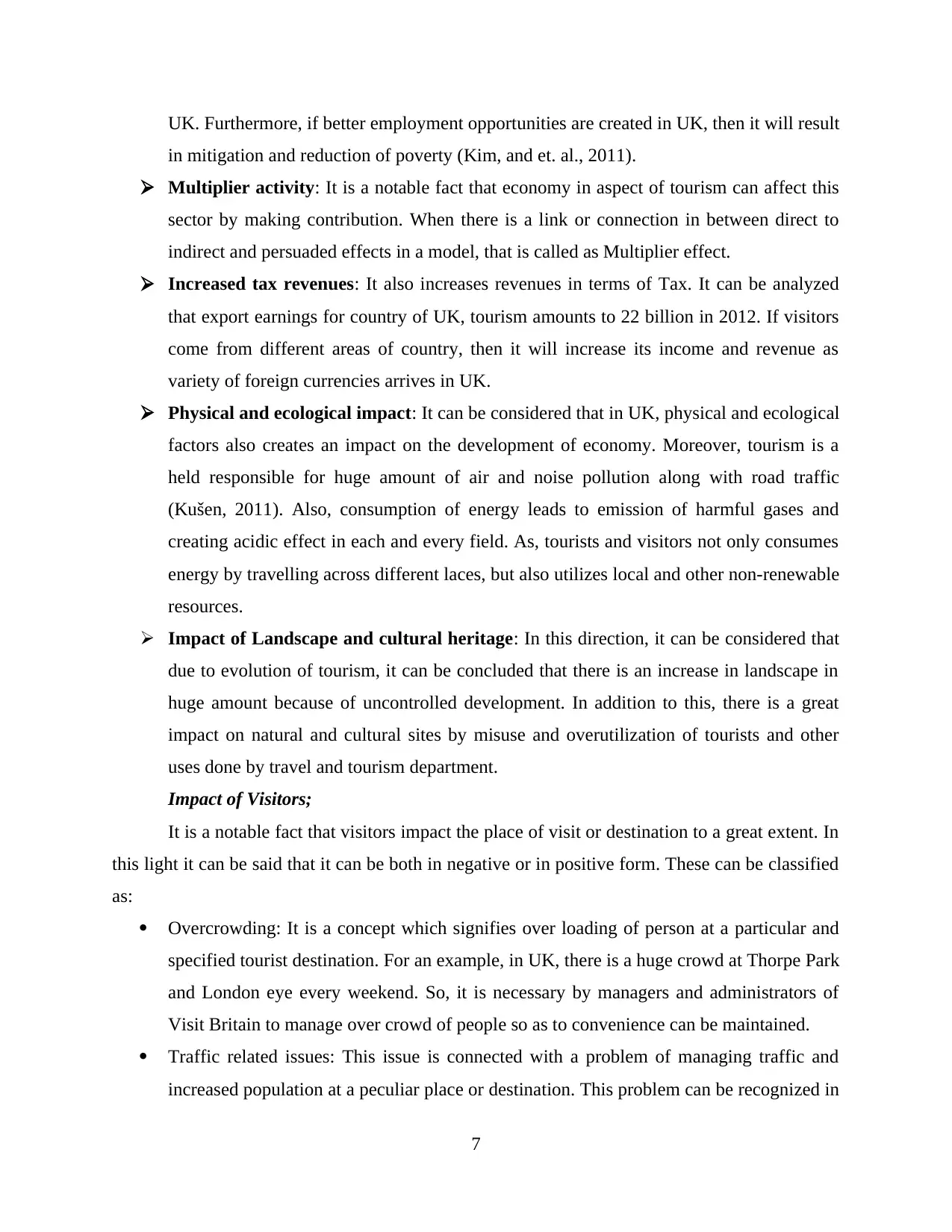
UK. Furthermore, if better employment opportunities are created in UK, then it will result
in mitigation and reduction of poverty (Kim, and et. al., 2011).
Multiplier activity: It is a notable fact that economy in aspect of tourism can affect this
sector by making contribution. When there is a link or connection in between direct to
indirect and persuaded effects in a model, that is called as Multiplier effect.
Increased tax revenues: It also increases revenues in terms of Tax. It can be analyzed
that export earnings for country of UK, tourism amounts to 22 billion in 2012. If visitors
come from different areas of country, then it will increase its income and revenue as
variety of foreign currencies arrives in UK.
Physical and ecological impact: It can be considered that in UK, physical and ecological
factors also creates an impact on the development of economy. Moreover, tourism is a
held responsible for huge amount of air and noise pollution along with road traffic
(Kušen, 2011). Also, consumption of energy leads to emission of harmful gases and
creating acidic effect in each and every field. As, tourists and visitors not only consumes
energy by travelling across different laces, but also utilizes local and other non-renewable
resources.
Impact of Landscape and cultural heritage: In this direction, it can be considered that
due to evolution of tourism, it can be concluded that there is an increase in landscape in
huge amount because of uncontrolled development. In addition to this, there is a great
impact on natural and cultural sites by misuse and overutilization of tourists and other
uses done by travel and tourism department.
Impact of Visitors;
It is a notable fact that visitors impact the place of visit or destination to a great extent. In
this light it can be said that it can be both in negative or in positive form. These can be classified
as:
Overcrowding: It is a concept which signifies over loading of person at a particular and
specified tourist destination. For an example, in UK, there is a huge crowd at Thorpe Park
and London eye every weekend. So, it is necessary by managers and administrators of
Visit Britain to manage over crowd of people so as to convenience can be maintained.
Traffic related issues: This issue is connected with a problem of managing traffic and
increased population at a peculiar place or destination. This problem can be recognized in
7
in mitigation and reduction of poverty (Kim, and et. al., 2011).
Multiplier activity: It is a notable fact that economy in aspect of tourism can affect this
sector by making contribution. When there is a link or connection in between direct to
indirect and persuaded effects in a model, that is called as Multiplier effect.
Increased tax revenues: It also increases revenues in terms of Tax. It can be analyzed
that export earnings for country of UK, tourism amounts to 22 billion in 2012. If visitors
come from different areas of country, then it will increase its income and revenue as
variety of foreign currencies arrives in UK.
Physical and ecological impact: It can be considered that in UK, physical and ecological
factors also creates an impact on the development of economy. Moreover, tourism is a
held responsible for huge amount of air and noise pollution along with road traffic
(Kušen, 2011). Also, consumption of energy leads to emission of harmful gases and
creating acidic effect in each and every field. As, tourists and visitors not only consumes
energy by travelling across different laces, but also utilizes local and other non-renewable
resources.
Impact of Landscape and cultural heritage: In this direction, it can be considered that
due to evolution of tourism, it can be concluded that there is an increase in landscape in
huge amount because of uncontrolled development. In addition to this, there is a great
impact on natural and cultural sites by misuse and overutilization of tourists and other
uses done by travel and tourism department.
Impact of Visitors;
It is a notable fact that visitors impact the place of visit or destination to a great extent. In
this light it can be said that it can be both in negative or in positive form. These can be classified
as:
Overcrowding: It is a concept which signifies over loading of person at a particular and
specified tourist destination. For an example, in UK, there is a huge crowd at Thorpe Park
and London eye every weekend. So, it is necessary by managers and administrators of
Visit Britain to manage over crowd of people so as to convenience can be maintained.
Traffic related issues: This issue is connected with a problem of managing traffic and
increased population at a peculiar place or destination. This problem can be recognized in
7
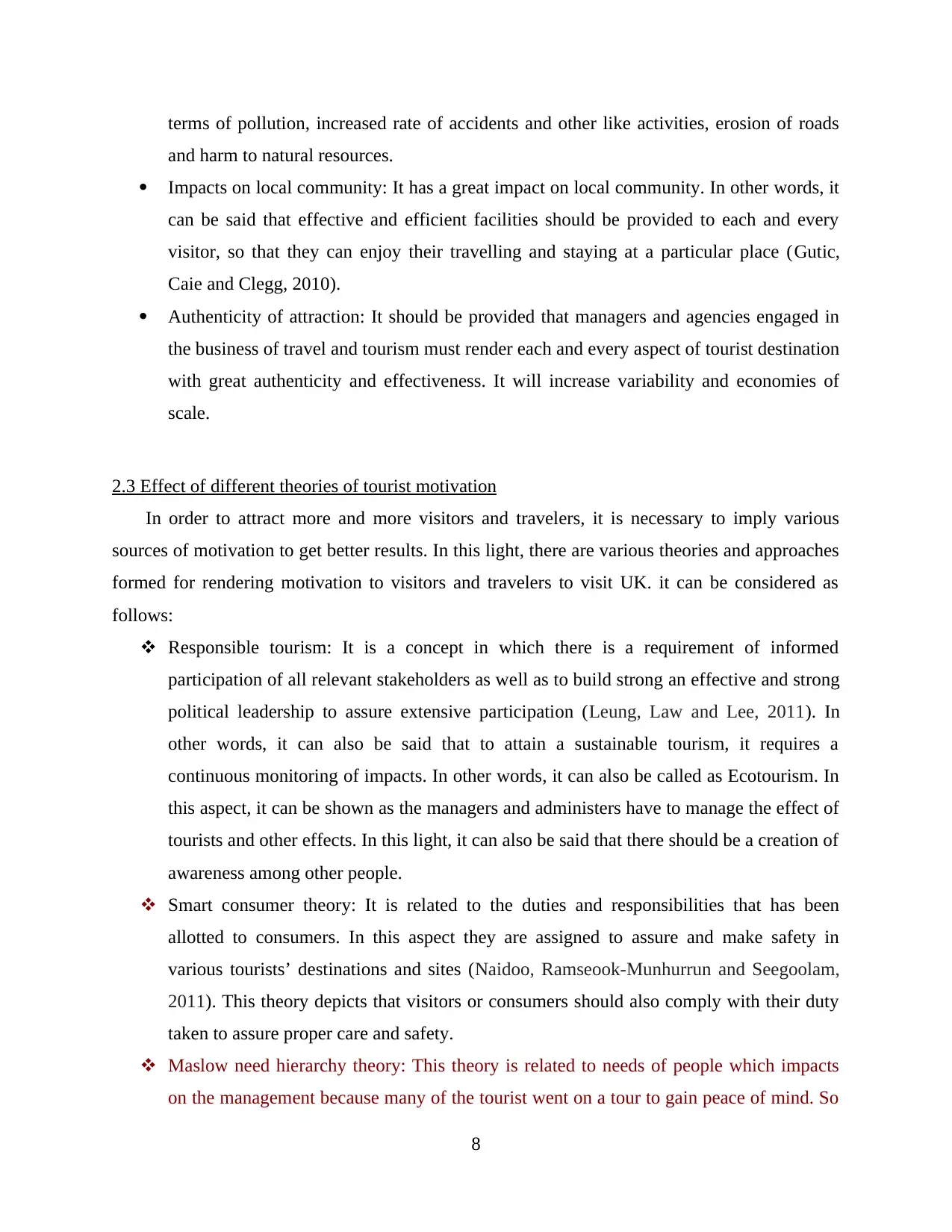
terms of pollution, increased rate of accidents and other like activities, erosion of roads
and harm to natural resources.
Impacts on local community: It has a great impact on local community. In other words, it
can be said that effective and efficient facilities should be provided to each and every
visitor, so that they can enjoy their travelling and staying at a particular place (Gutic,
Caie and Clegg, 2010).
Authenticity of attraction: It should be provided that managers and agencies engaged in
the business of travel and tourism must render each and every aspect of tourist destination
with great authenticity and effectiveness. It will increase variability and economies of
scale.
2.3 Effect of different theories of tourist motivation
In order to attract more and more visitors and travelers, it is necessary to imply various
sources of motivation to get better results. In this light, there are various theories and approaches
formed for rendering motivation to visitors and travelers to visit UK. it can be considered as
follows:
Responsible tourism: It is a concept in which there is a requirement of informed
participation of all relevant stakeholders as well as to build strong an effective and strong
political leadership to assure extensive participation (Leung, Law and Lee, 2011). In
other words, it can also be said that to attain a sustainable tourism, it requires a
continuous monitoring of impacts. In other words, it can also be called as Ecotourism. In
this aspect, it can be shown as the managers and administers have to manage the effect of
tourists and other effects. In this light, it can also be said that there should be a creation of
awareness among other people.
Smart consumer theory: It is related to the duties and responsibilities that has been
allotted to consumers. In this aspect they are assigned to assure and make safety in
various tourists’ destinations and sites (Naidoo, Ramseook-Munhurrun and Seegoolam,
2011). This theory depicts that visitors or consumers should also comply with their duty
taken to assure proper care and safety.
Maslow need hierarchy theory: This theory is related to needs of people which impacts
on the management because many of the tourist went on a tour to gain peace of mind. So
8
and harm to natural resources.
Impacts on local community: It has a great impact on local community. In other words, it
can be said that effective and efficient facilities should be provided to each and every
visitor, so that they can enjoy their travelling and staying at a particular place (Gutic,
Caie and Clegg, 2010).
Authenticity of attraction: It should be provided that managers and agencies engaged in
the business of travel and tourism must render each and every aspect of tourist destination
with great authenticity and effectiveness. It will increase variability and economies of
scale.
2.3 Effect of different theories of tourist motivation
In order to attract more and more visitors and travelers, it is necessary to imply various
sources of motivation to get better results. In this light, there are various theories and approaches
formed for rendering motivation to visitors and travelers to visit UK. it can be considered as
follows:
Responsible tourism: It is a concept in which there is a requirement of informed
participation of all relevant stakeholders as well as to build strong an effective and strong
political leadership to assure extensive participation (Leung, Law and Lee, 2011). In
other words, it can also be said that to attain a sustainable tourism, it requires a
continuous monitoring of impacts. In other words, it can also be called as Ecotourism. In
this aspect, it can be shown as the managers and administers have to manage the effect of
tourists and other effects. In this light, it can also be said that there should be a creation of
awareness among other people.
Smart consumer theory: It is related to the duties and responsibilities that has been
allotted to consumers. In this aspect they are assigned to assure and make safety in
various tourists’ destinations and sites (Naidoo, Ramseook-Munhurrun and Seegoolam,
2011). This theory depicts that visitors or consumers should also comply with their duty
taken to assure proper care and safety.
Maslow need hierarchy theory: This theory is related to needs of people which impacts
on the management because many of the tourist went on a tour to gain peace of mind. So
8
Secure Best Marks with AI Grader
Need help grading? Try our AI Grader for instant feedback on your assignments.
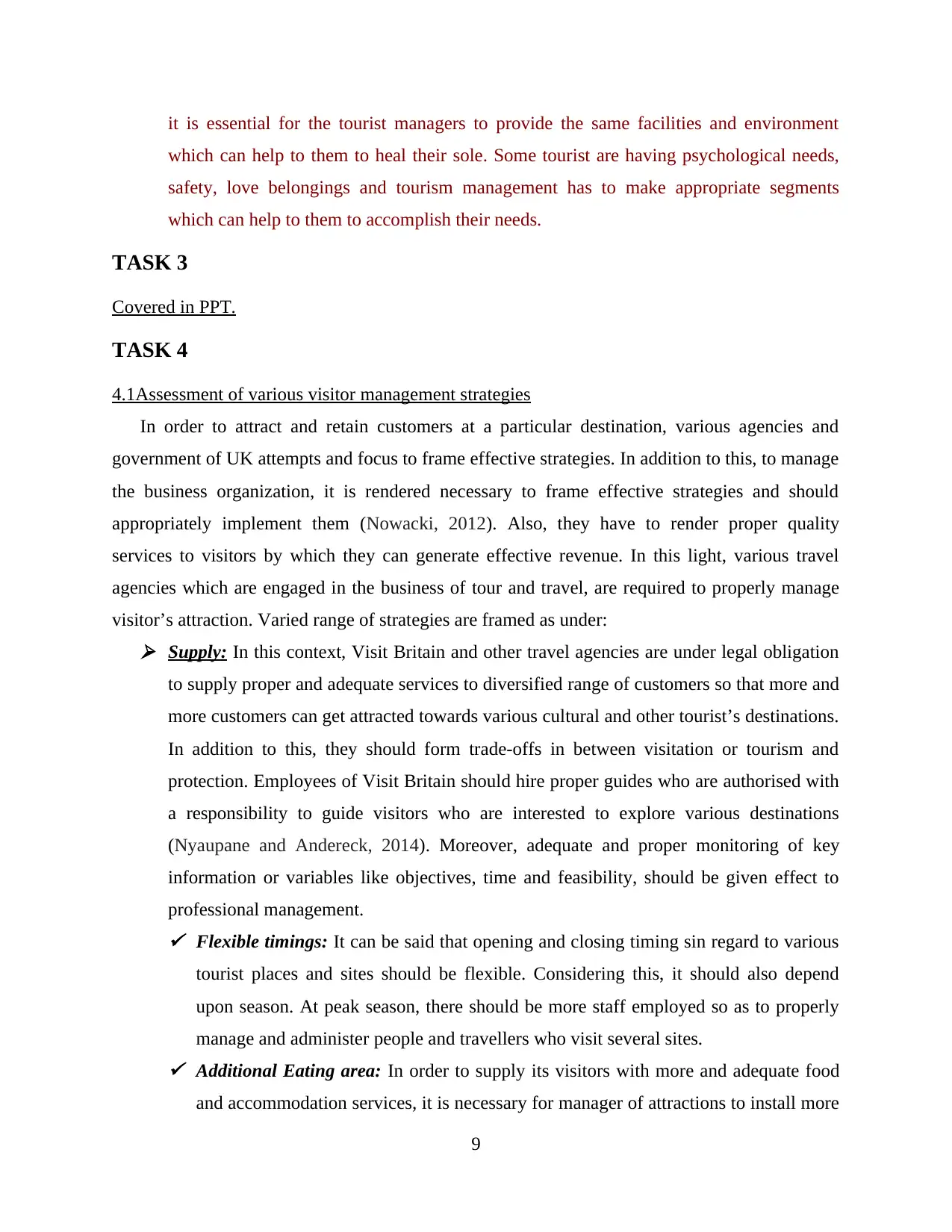
it is essential for the tourist managers to provide the same facilities and environment
which can help to them to heal their sole. Some tourist are having psychological needs,
safety, love belongings and tourism management has to make appropriate segments
which can help to them to accomplish their needs.
TASK 3
Covered in PPT.
TASK 4
4.1Assessment of various visitor management strategies
In order to attract and retain customers at a particular destination, various agencies and
government of UK attempts and focus to frame effective strategies. In addition to this, to manage
the business organization, it is rendered necessary to frame effective strategies and should
appropriately implement them (Nowacki, 2012). Also, they have to render proper quality
services to visitors by which they can generate effective revenue. In this light, various travel
agencies which are engaged in the business of tour and travel, are required to properly manage
visitor’s attraction. Varied range of strategies are framed as under: Supply: In this context, Visit Britain and other travel agencies are under legal obligation
to supply proper and adequate services to diversified range of customers so that more and
more customers can get attracted towards various cultural and other tourist’s destinations.
In addition to this, they should form trade-offs in between visitation or tourism and
protection. Employees of Visit Britain should hire proper guides who are authorised with
a responsibility to guide visitors who are interested to explore various destinations
(Nyaupane and Andereck, 2014). Moreover, adequate and proper monitoring of key
information or variables like objectives, time and feasibility, should be given effect to
professional management.
Flexible timings: It can be said that opening and closing timing sin regard to various
tourist places and sites should be flexible. Considering this, it should also depend
upon season. At peak season, there should be more staff employed so as to properly
manage and administer people and travellers who visit several sites.
Additional Eating area: In order to supply its visitors with more and adequate food
and accommodation services, it is necessary for manager of attractions to install more
9
which can help to them to heal their sole. Some tourist are having psychological needs,
safety, love belongings and tourism management has to make appropriate segments
which can help to them to accomplish their needs.
TASK 3
Covered in PPT.
TASK 4
4.1Assessment of various visitor management strategies
In order to attract and retain customers at a particular destination, various agencies and
government of UK attempts and focus to frame effective strategies. In addition to this, to manage
the business organization, it is rendered necessary to frame effective strategies and should
appropriately implement them (Nowacki, 2012). Also, they have to render proper quality
services to visitors by which they can generate effective revenue. In this light, various travel
agencies which are engaged in the business of tour and travel, are required to properly manage
visitor’s attraction. Varied range of strategies are framed as under: Supply: In this context, Visit Britain and other travel agencies are under legal obligation
to supply proper and adequate services to diversified range of customers so that more and
more customers can get attracted towards various cultural and other tourist’s destinations.
In addition to this, they should form trade-offs in between visitation or tourism and
protection. Employees of Visit Britain should hire proper guides who are authorised with
a responsibility to guide visitors who are interested to explore various destinations
(Nyaupane and Andereck, 2014). Moreover, adequate and proper monitoring of key
information or variables like objectives, time and feasibility, should be given effect to
professional management.
Flexible timings: It can be said that opening and closing timing sin regard to various
tourist places and sites should be flexible. Considering this, it should also depend
upon season. At peak season, there should be more staff employed so as to properly
manage and administer people and travellers who visit several sites.
Additional Eating area: In order to supply its visitors with more and adequate food
and accommodation services, it is necessary for manager of attractions to install more
9
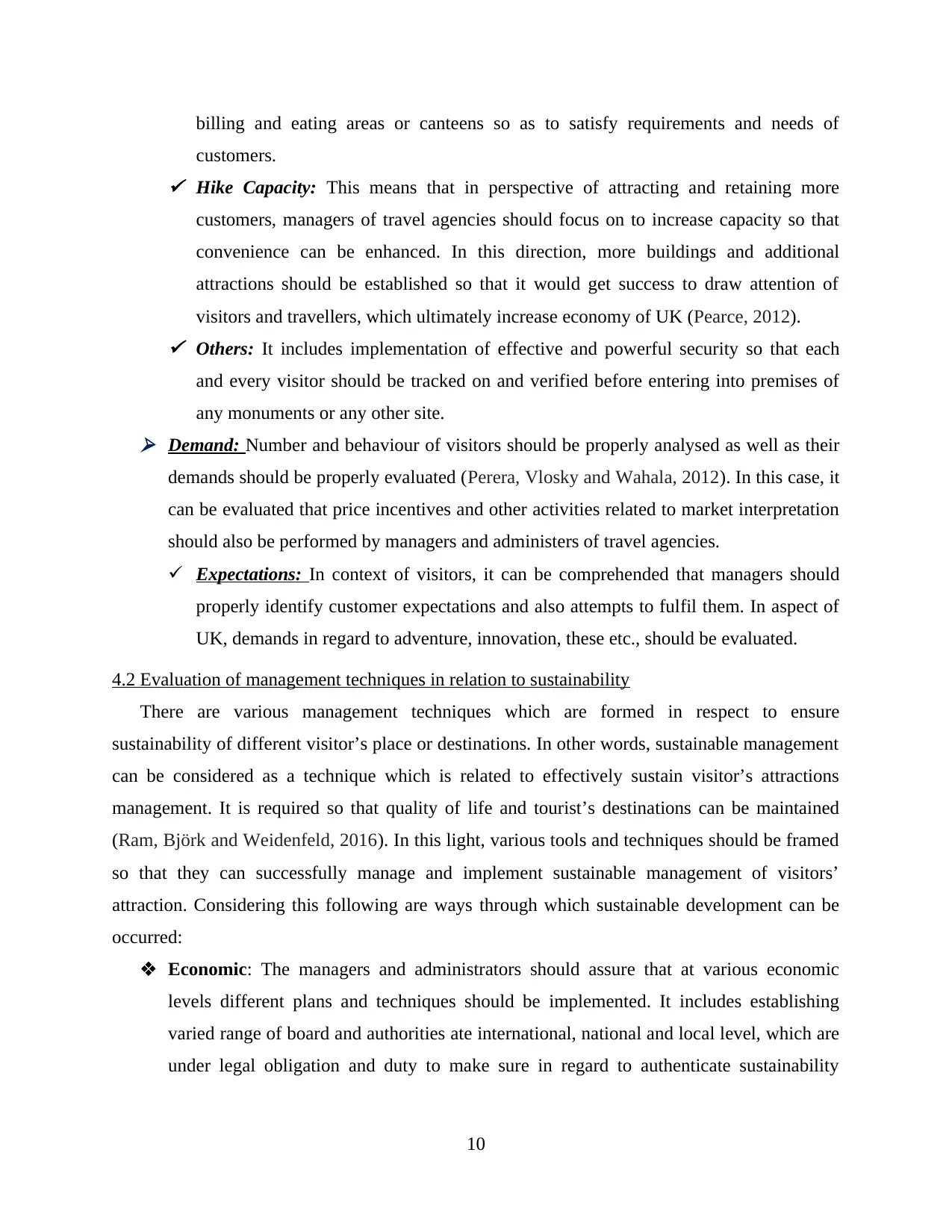
billing and eating areas or canteens so as to satisfy requirements and needs of
customers.
Hike Capacity: This means that in perspective of attracting and retaining more
customers, managers of travel agencies should focus on to increase capacity so that
convenience can be enhanced. In this direction, more buildings and additional
attractions should be established so that it would get success to draw attention of
visitors and travellers, which ultimately increase economy of UK (Pearce, 2012).
Others: It includes implementation of effective and powerful security so that each
and every visitor should be tracked on and verified before entering into premises of
any monuments or any other site. Demand: Number and behaviour of visitors should be properly analysed as well as their
demands should be properly evaluated (Perera, Vlosky and Wahala, 2012). In this case, it
can be evaluated that price incentives and other activities related to market interpretation
should also be performed by managers and administers of travel agencies.
Expectations: In context of visitors, it can be comprehended that managers should
properly identify customer expectations and also attempts to fulfil them. In aspect of
UK, demands in regard to adventure, innovation, these etc., should be evaluated.
4.2 Evaluation of management techniques in relation to sustainability
There are various management techniques which are formed in respect to ensure
sustainability of different visitor’s place or destinations. In other words, sustainable management
can be considered as a technique which is related to effectively sustain visitor’s attractions
management. It is required so that quality of life and tourist’s destinations can be maintained
(Ram, Björk and Weidenfeld, 2016). In this light, various tools and techniques should be framed
so that they can successfully manage and implement sustainable management of visitors’
attraction. Considering this following are ways through which sustainable development can be
occurred:
Economic: The managers and administrators should assure that at various economic
levels different plans and techniques should be implemented. It includes establishing
varied range of board and authorities ate international, national and local level, which are
under legal obligation and duty to make sure in regard to authenticate sustainability
10
customers.
Hike Capacity: This means that in perspective of attracting and retaining more
customers, managers of travel agencies should focus on to increase capacity so that
convenience can be enhanced. In this direction, more buildings and additional
attractions should be established so that it would get success to draw attention of
visitors and travellers, which ultimately increase economy of UK (Pearce, 2012).
Others: It includes implementation of effective and powerful security so that each
and every visitor should be tracked on and verified before entering into premises of
any monuments or any other site. Demand: Number and behaviour of visitors should be properly analysed as well as their
demands should be properly evaluated (Perera, Vlosky and Wahala, 2012). In this case, it
can be evaluated that price incentives and other activities related to market interpretation
should also be performed by managers and administers of travel agencies.
Expectations: In context of visitors, it can be comprehended that managers should
properly identify customer expectations and also attempts to fulfil them. In aspect of
UK, demands in regard to adventure, innovation, these etc., should be evaluated.
4.2 Evaluation of management techniques in relation to sustainability
There are various management techniques which are formed in respect to ensure
sustainability of different visitor’s place or destinations. In other words, sustainable management
can be considered as a technique which is related to effectively sustain visitor’s attractions
management. It is required so that quality of life and tourist’s destinations can be maintained
(Ram, Björk and Weidenfeld, 2016). In this light, various tools and techniques should be framed
so that they can successfully manage and implement sustainable management of visitors’
attraction. Considering this following are ways through which sustainable development can be
occurred:
Economic: The managers and administrators should assure that at various economic
levels different plans and techniques should be implemented. It includes establishing
varied range of board and authorities ate international, national and local level, which are
under legal obligation and duty to make sure in regard to authenticate sustainability
10
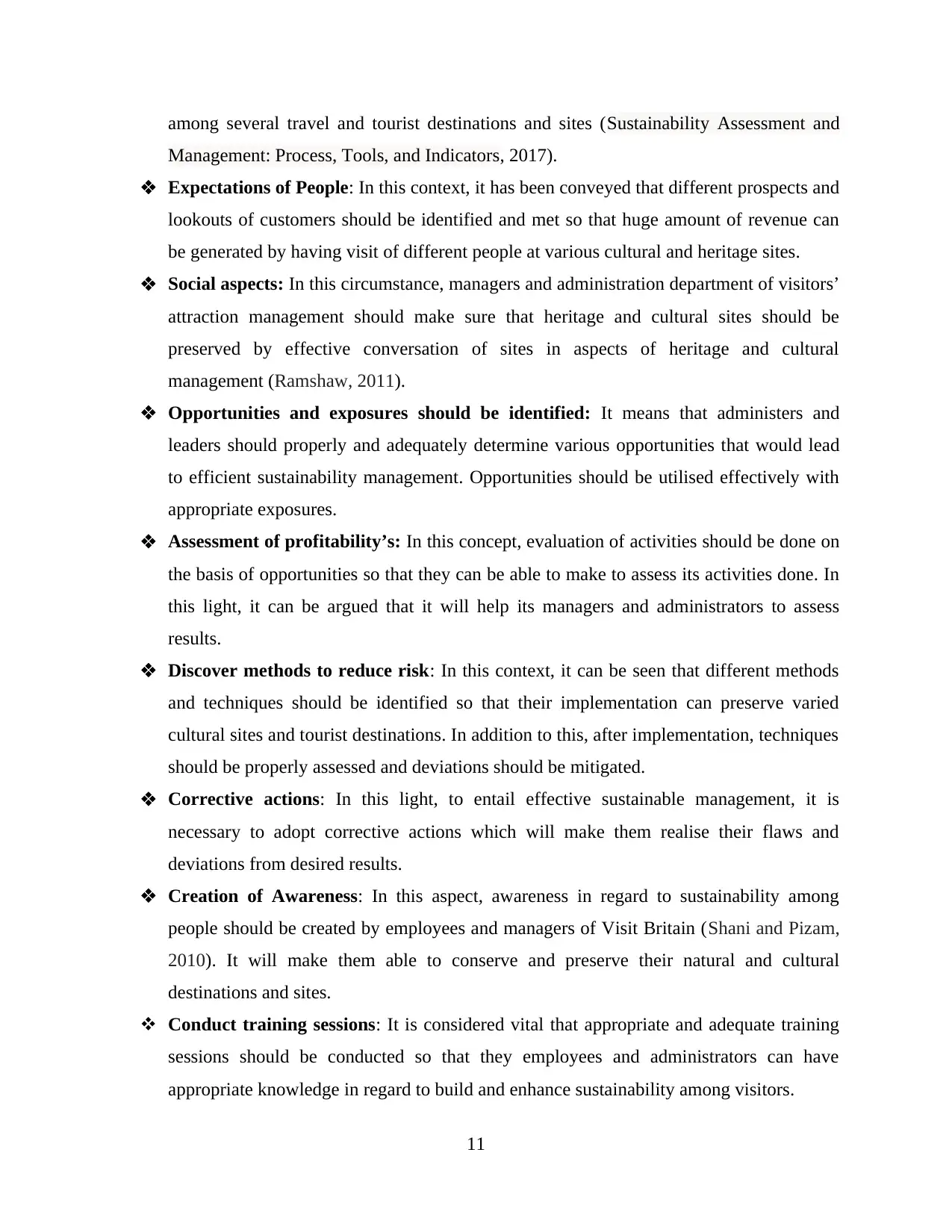
among several travel and tourist destinations and sites (Sustainability Assessment and
Management: Process, Tools, and Indicators, 2017).
Expectations of People: In this context, it has been conveyed that different prospects and
lookouts of customers should be identified and met so that huge amount of revenue can
be generated by having visit of different people at various cultural and heritage sites.
Social aspects: In this circumstance, managers and administration department of visitors’
attraction management should make sure that heritage and cultural sites should be
preserved by effective conversation of sites in aspects of heritage and cultural
management (Ramshaw, 2011).
Opportunities and exposures should be identified: It means that administers and
leaders should properly and adequately determine various opportunities that would lead
to efficient sustainability management. Opportunities should be utilised effectively with
appropriate exposures.
Assessment of profitability’s: In this concept, evaluation of activities should be done on
the basis of opportunities so that they can be able to make to assess its activities done. In
this light, it can be argued that it will help its managers and administrators to assess
results.
Discover methods to reduce risk: In this context, it can be seen that different methods
and techniques should be identified so that their implementation can preserve varied
cultural sites and tourist destinations. In addition to this, after implementation, techniques
should be properly assessed and deviations should be mitigated.
Corrective actions: In this light, to entail effective sustainable management, it is
necessary to adopt corrective actions which will make them realise their flaws and
deviations from desired results.
Creation of Awareness: In this aspect, awareness in regard to sustainability among
people should be created by employees and managers of Visit Britain (Shani and Pizam,
2010). It will make them able to conserve and preserve their natural and cultural
destinations and sites.
Conduct training sessions: It is considered vital that appropriate and adequate training
sessions should be conducted so that they employees and administrators can have
appropriate knowledge in regard to build and enhance sustainability among visitors.
11
Management: Process, Tools, and Indicators, 2017).
Expectations of People: In this context, it has been conveyed that different prospects and
lookouts of customers should be identified and met so that huge amount of revenue can
be generated by having visit of different people at various cultural and heritage sites.
Social aspects: In this circumstance, managers and administration department of visitors’
attraction management should make sure that heritage and cultural sites should be
preserved by effective conversation of sites in aspects of heritage and cultural
management (Ramshaw, 2011).
Opportunities and exposures should be identified: It means that administers and
leaders should properly and adequately determine various opportunities that would lead
to efficient sustainability management. Opportunities should be utilised effectively with
appropriate exposures.
Assessment of profitability’s: In this concept, evaluation of activities should be done on
the basis of opportunities so that they can be able to make to assess its activities done. In
this light, it can be argued that it will help its managers and administrators to assess
results.
Discover methods to reduce risk: In this context, it can be seen that different methods
and techniques should be identified so that their implementation can preserve varied
cultural sites and tourist destinations. In addition to this, after implementation, techniques
should be properly assessed and deviations should be mitigated.
Corrective actions: In this light, to entail effective sustainable management, it is
necessary to adopt corrective actions which will make them realise their flaws and
deviations from desired results.
Creation of Awareness: In this aspect, awareness in regard to sustainability among
people should be created by employees and managers of Visit Britain (Shani and Pizam,
2010). It will make them able to conserve and preserve their natural and cultural
destinations and sites.
Conduct training sessions: It is considered vital that appropriate and adequate training
sessions should be conducted so that they employees and administrators can have
appropriate knowledge in regard to build and enhance sustainability among visitors.
11
Paraphrase This Document
Need a fresh take? Get an instant paraphrase of this document with our AI Paraphraser
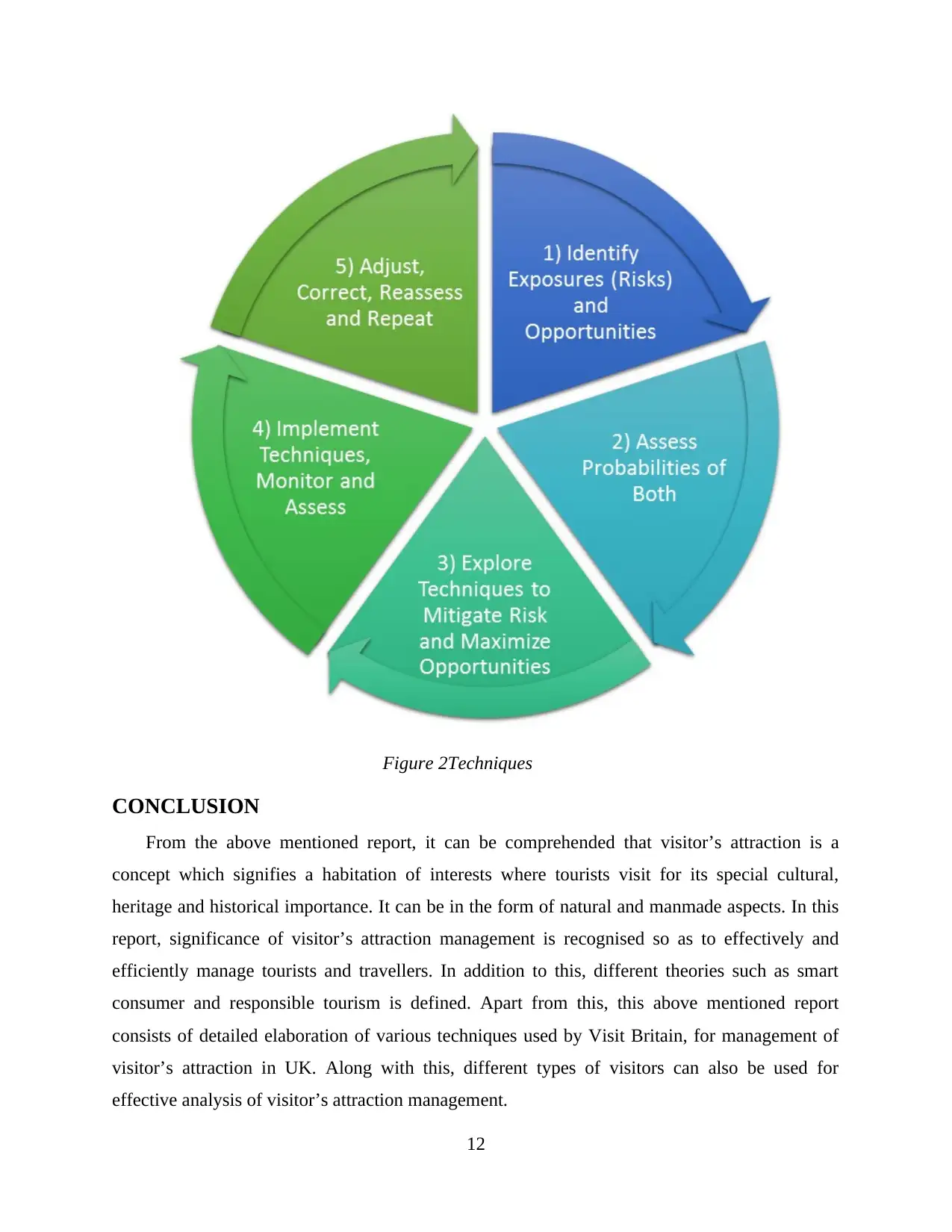
Figure 2Techniques
CONCLUSION
From the above mentioned report, it can be comprehended that visitor’s attraction is a
concept which signifies a habitation of interests where tourists visit for its special cultural,
heritage and historical importance. It can be in the form of natural and manmade aspects. In this
report, significance of visitor’s attraction management is recognised so as to effectively and
efficiently manage tourists and travellers. In addition to this, different theories such as smart
consumer and responsible tourism is defined. Apart from this, this above mentioned report
consists of detailed elaboration of various techniques used by Visit Britain, for management of
visitor’s attraction in UK. Along with this, different types of visitors can also be used for
effective analysis of visitor’s attraction management.
12
CONCLUSION
From the above mentioned report, it can be comprehended that visitor’s attraction is a
concept which signifies a habitation of interests where tourists visit for its special cultural,
heritage and historical importance. It can be in the form of natural and manmade aspects. In this
report, significance of visitor’s attraction management is recognised so as to effectively and
efficiently manage tourists and travellers. In addition to this, different theories such as smart
consumer and responsible tourism is defined. Apart from this, this above mentioned report
consists of detailed elaboration of various techniques used by Visit Britain, for management of
visitor’s attraction in UK. Along with this, different types of visitors can also be used for
effective analysis of visitor’s attraction management.
12
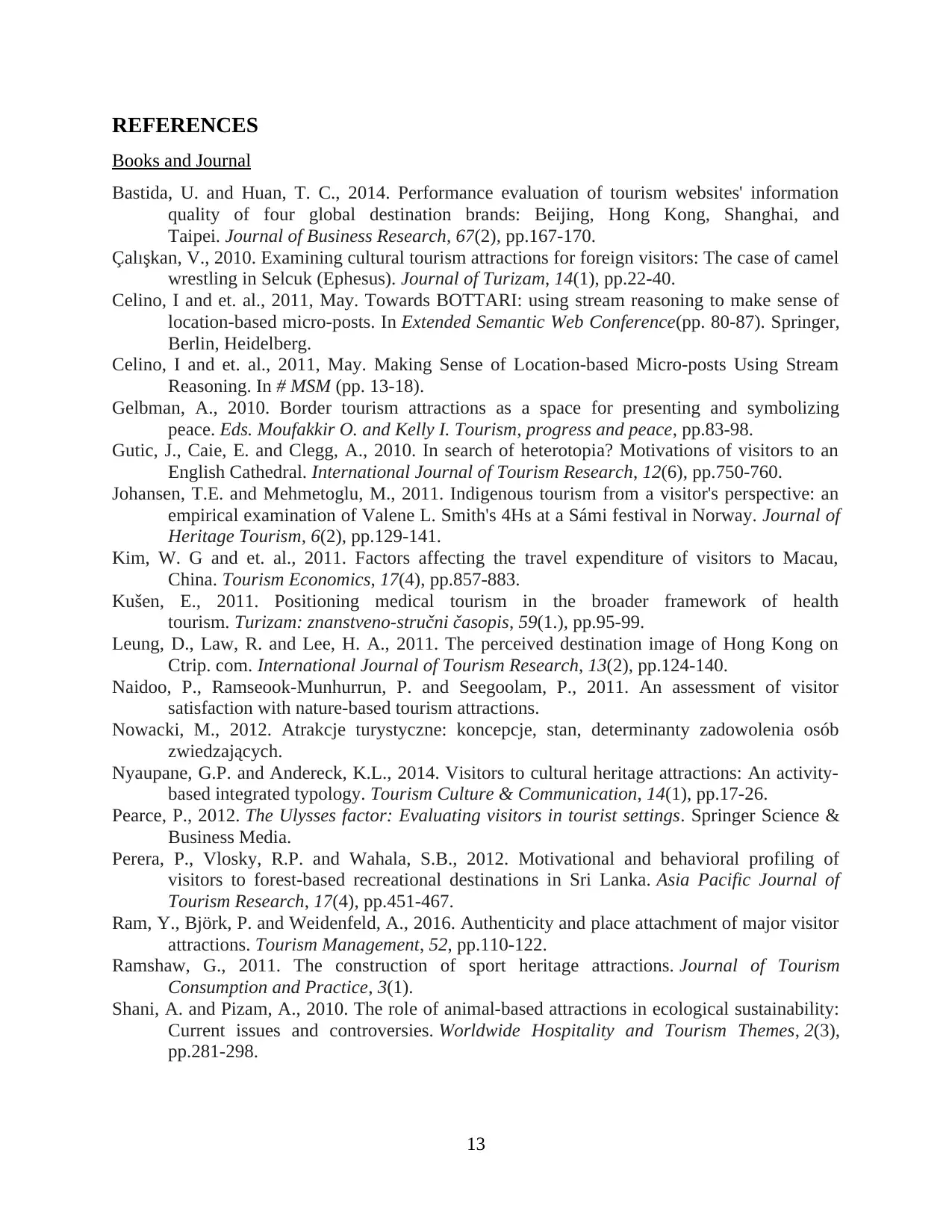
REFERENCES
Books and Journal
Bastida, U. and Huan, T. C., 2014. Performance evaluation of tourism websites' information
quality of four global destination brands: Beijing, Hong Kong, Shanghai, and
Taipei. Journal of Business Research, 67(2), pp.167-170.
Çalışkan, V., 2010. Examining cultural tourism attractions for foreign visitors: The case of camel
wrestling in Selcuk (Ephesus). Journal of Turizam, 14(1), pp.22-40.
Celino, I and et. al., 2011, May. Towards BOTTARI: using stream reasoning to make sense of
location-based micro-posts. In Extended Semantic Web Conference(pp. 80-87). Springer,
Berlin, Heidelberg.
Celino, I and et. al., 2011, May. Making Sense of Location-based Micro-posts Using Stream
Reasoning. In # MSM (pp. 13-18).
Gelbman, A., 2010. Border tourism attractions as a space for presenting and symbolizing
peace. Eds. Moufakkir O. and Kelly I. Tourism, progress and peace, pp.83-98.
Gutic, J., Caie, E. and Clegg, A., 2010. In search of heterotopia? Motivations of visitors to an
English Cathedral. International Journal of Tourism Research, 12(6), pp.750-760.
Johansen, T.E. and Mehmetoglu, M., 2011. Indigenous tourism from a visitor's perspective: an
empirical examination of Valene L. Smith's 4Hs at a Sámi festival in Norway. Journal of
Heritage Tourism, 6(2), pp.129-141.
Kim, W. G and et. al., 2011. Factors affecting the travel expenditure of visitors to Macau,
China. Tourism Economics, 17(4), pp.857-883.
Kušen, E., 2011. Positioning medical tourism in the broader framework of health
tourism. Turizam: znanstveno-stručni časopis, 59(1.), pp.95-99.
Leung, D., Law, R. and Lee, H. A., 2011. The perceived destination image of Hong Kong on
Ctrip. com. International Journal of Tourism Research, 13(2), pp.124-140.
Naidoo, P., Ramseook-Munhurrun, P. and Seegoolam, P., 2011. An assessment of visitor
satisfaction with nature-based tourism attractions.
Nowacki, M., 2012. Atrakcje turystyczne: koncepcje, stan, determinanty zadowolenia osób
zwiedzających.
Nyaupane, G.P. and Andereck, K.L., 2014. Visitors to cultural heritage attractions: An activity-
based integrated typology. Tourism Culture & Communication, 14(1), pp.17-26.
Pearce, P., 2012. The Ulysses factor: Evaluating visitors in tourist settings. Springer Science &
Business Media.
Perera, P., Vlosky, R.P. and Wahala, S.B., 2012. Motivational and behavioral profiling of
visitors to forest-based recreational destinations in Sri Lanka. Asia Pacific Journal of
Tourism Research, 17(4), pp.451-467.
Ram, Y., Björk, P. and Weidenfeld, A., 2016. Authenticity and place attachment of major visitor
attractions. Tourism Management, 52, pp.110-122.
Ramshaw, G., 2011. The construction of sport heritage attractions. Journal of Tourism
Consumption and Practice, 3(1).
Shani, A. and Pizam, A., 2010. The role of animal-based attractions in ecological sustainability:
Current issues and controversies. Worldwide Hospitality and Tourism Themes, 2(3),
pp.281-298.
13
Books and Journal
Bastida, U. and Huan, T. C., 2014. Performance evaluation of tourism websites' information
quality of four global destination brands: Beijing, Hong Kong, Shanghai, and
Taipei. Journal of Business Research, 67(2), pp.167-170.
Çalışkan, V., 2010. Examining cultural tourism attractions for foreign visitors: The case of camel
wrestling in Selcuk (Ephesus). Journal of Turizam, 14(1), pp.22-40.
Celino, I and et. al., 2011, May. Towards BOTTARI: using stream reasoning to make sense of
location-based micro-posts. In Extended Semantic Web Conference(pp. 80-87). Springer,
Berlin, Heidelberg.
Celino, I and et. al., 2011, May. Making Sense of Location-based Micro-posts Using Stream
Reasoning. In # MSM (pp. 13-18).
Gelbman, A., 2010. Border tourism attractions as a space for presenting and symbolizing
peace. Eds. Moufakkir O. and Kelly I. Tourism, progress and peace, pp.83-98.
Gutic, J., Caie, E. and Clegg, A., 2010. In search of heterotopia? Motivations of visitors to an
English Cathedral. International Journal of Tourism Research, 12(6), pp.750-760.
Johansen, T.E. and Mehmetoglu, M., 2011. Indigenous tourism from a visitor's perspective: an
empirical examination of Valene L. Smith's 4Hs at a Sámi festival in Norway. Journal of
Heritage Tourism, 6(2), pp.129-141.
Kim, W. G and et. al., 2011. Factors affecting the travel expenditure of visitors to Macau,
China. Tourism Economics, 17(4), pp.857-883.
Kušen, E., 2011. Positioning medical tourism in the broader framework of health
tourism. Turizam: znanstveno-stručni časopis, 59(1.), pp.95-99.
Leung, D., Law, R. and Lee, H. A., 2011. The perceived destination image of Hong Kong on
Ctrip. com. International Journal of Tourism Research, 13(2), pp.124-140.
Naidoo, P., Ramseook-Munhurrun, P. and Seegoolam, P., 2011. An assessment of visitor
satisfaction with nature-based tourism attractions.
Nowacki, M., 2012. Atrakcje turystyczne: koncepcje, stan, determinanty zadowolenia osób
zwiedzających.
Nyaupane, G.P. and Andereck, K.L., 2014. Visitors to cultural heritage attractions: An activity-
based integrated typology. Tourism Culture & Communication, 14(1), pp.17-26.
Pearce, P., 2012. The Ulysses factor: Evaluating visitors in tourist settings. Springer Science &
Business Media.
Perera, P., Vlosky, R.P. and Wahala, S.B., 2012. Motivational and behavioral profiling of
visitors to forest-based recreational destinations in Sri Lanka. Asia Pacific Journal of
Tourism Research, 17(4), pp.451-467.
Ram, Y., Björk, P. and Weidenfeld, A., 2016. Authenticity and place attachment of major visitor
attractions. Tourism Management, 52, pp.110-122.
Ramshaw, G., 2011. The construction of sport heritage attractions. Journal of Tourism
Consumption and Practice, 3(1).
Shani, A. and Pizam, A., 2010. The role of animal-based attractions in ecological sustainability:
Current issues and controversies. Worldwide Hospitality and Tourism Themes, 2(3),
pp.281-298.
13
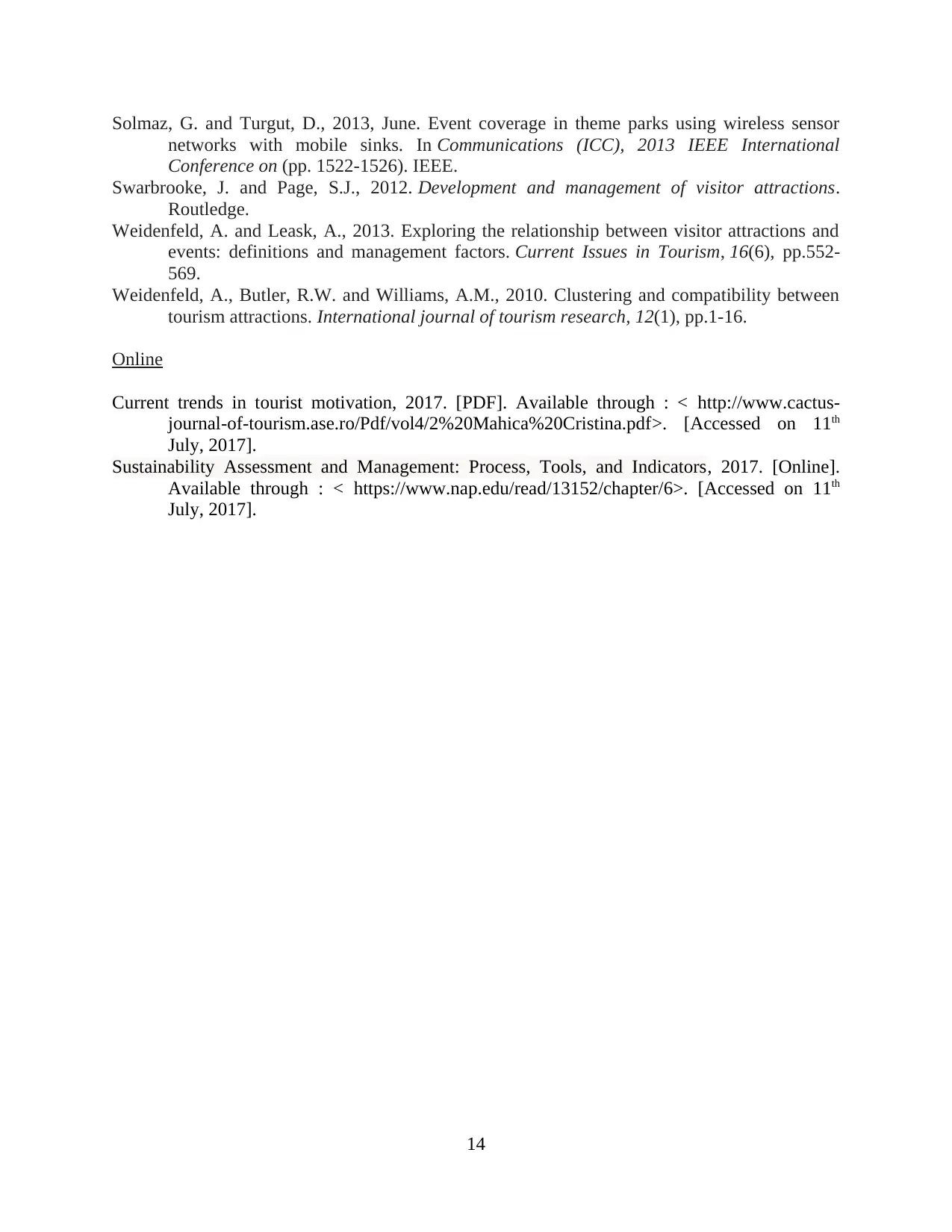
Solmaz, G. and Turgut, D., 2013, June. Event coverage in theme parks using wireless sensor
networks with mobile sinks. In Communications (ICC), 2013 IEEE International
Conference on (pp. 1522-1526). IEEE.
Swarbrooke, J. and Page, S.J., 2012. Development and management of visitor attractions.
Routledge.
Weidenfeld, A. and Leask, A., 2013. Exploring the relationship between visitor attractions and
events: definitions and management factors. Current Issues in Tourism, 16(6), pp.552-
569.
Weidenfeld, A., Butler, R.W. and Williams, A.M., 2010. Clustering and compatibility between
tourism attractions. International journal of tourism research, 12(1), pp.1-16.
Online
Current trends in tourist motivation, 2017. [PDF]. Available through : < http://www.cactus-
journal-of-tourism.ase.ro/Pdf/vol4/2%20Mahica%20Cristina.pdf>. [Accessed on 11th
July, 2017].
Sustainability Assessment and Management: Process, Tools, and Indicators, 2017. [Online].
Available through : < https://www.nap.edu/read/13152/chapter/6>. [Accessed on 11th
July, 2017].
14
networks with mobile sinks. In Communications (ICC), 2013 IEEE International
Conference on (pp. 1522-1526). IEEE.
Swarbrooke, J. and Page, S.J., 2012. Development and management of visitor attractions.
Routledge.
Weidenfeld, A. and Leask, A., 2013. Exploring the relationship between visitor attractions and
events: definitions and management factors. Current Issues in Tourism, 16(6), pp.552-
569.
Weidenfeld, A., Butler, R.W. and Williams, A.M., 2010. Clustering and compatibility between
tourism attractions. International journal of tourism research, 12(1), pp.1-16.
Online
Current trends in tourist motivation, 2017. [PDF]. Available through : < http://www.cactus-
journal-of-tourism.ase.ro/Pdf/vol4/2%20Mahica%20Cristina.pdf>. [Accessed on 11th
July, 2017].
Sustainability Assessment and Management: Process, Tools, and Indicators, 2017. [Online].
Available through : < https://www.nap.edu/read/13152/chapter/6>. [Accessed on 11th
July, 2017].
14
1 out of 16
Related Documents
Your All-in-One AI-Powered Toolkit for Academic Success.
+13062052269
info@desklib.com
Available 24*7 on WhatsApp / Email
![[object Object]](/_next/static/media/star-bottom.7253800d.svg)
Unlock your academic potential
© 2024 | Zucol Services PVT LTD | All rights reserved.





